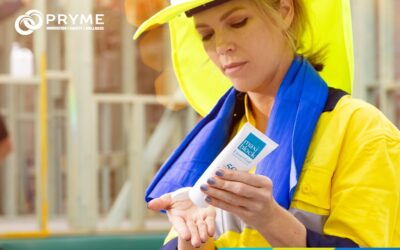Addressing Heat-Related Workplace Injuries

Workers in various industries often face significant health and safety risks due to exposure to extreme heat. Heat-related incidents can lead to a wide range of injuries, highlighting the critical need for effective preventive measures and worker education. A recent study explored the experiences of workers exposed to high temperatures in their workplaces, ” Prevention of Occupational Heat-Related Injuries in Australia” – available at: www.ncbi.nlm.nih.gov/pmc/articles/PMC7036960.
Education, communication, and shared responsibility among workers, supervisors, and organisations are vital for safeguarding the health and safety of workers in high-temperature environments.
The study delved deeply into the experiences of the interviewees and uncovered an additional layer of complexity in the battle against heat-related incidents. While PPE is vital for protecting workers from various occupational hazards, it was found that in some instances, PPE itself can inadvertently contribute to heat stress and danger.
The study not only revealed the physical toll of heat exposure but also underscored its significant impact on mental health and cognitive function. Several interviewees shared their struggles with mental well-being and the cognitive challenges they faced due to overheating. The insights highlight the urgency of addressing not only the physical safety of workers but also their mental and cognitive well-being when combating heat-related incidents.
So, what are the circumstances and outcomes of heat-related incidents, contributing factors at the individual and organisation level.
Circumstances & Outcomes
A Spectrum of Incidents: Heat exposure resulted in a spectrum of incidents affecting workers, with consequences ranging from minor impacts to life-altering events. These incidents encompassed various scenarios, including severe traffic accidents during hot weather conditions.
Exemplifying Health Risks: One interviewee recounted a particularly harrowing experience, suffering a cerebellar infarction due to extreme dehydration and hyperthermia, exemplifying the major health impacts of heat-related illnesses. Additionally, minor impacts like heat exhaustion, heat rashes, and discomfort were common among other participants, collectively highlighting the diverse range of effects that heat exposure can have on the workforce.
Contributing Factors
The study identified multiple factors at different levels that contribute to heat-related incidents:
At the Individual Level
- Acclimatisation: Workers unaccustomed to hot environments were more vulnerable to heat-related incidents. Acclimatisation was essential, and those who did not have the opportunity were at higher risk.
- Dehydration and Fatigue: Dehydration frequently leads to heat stress symptoms and injuries, with a notable accumulative effect. Workers often experience dehydration over several days due to excessive sweating and insufficient fluid intake. As days passed in the hot environment, they progressively felt weaker, less alert, and more prone to cramps and injuries. Addressing dehydration is not just a momentary concern but vital for sustained worker well-being and safety.
- Age: Both younger and older workers could be at risk. Younger workers often displayed overconfidence and took more risks, while older workers faced increased vulnerability.
At the Interpersonal Level
- Self-Presentation: Peer pressure and concerns about self-presentation in the workplace influenced workers to forego breaks and not report heat-related issues due to fears of being perceived as “weak.”
At the Organisational Level
- Workplace Environment: The type of work environment, whether indoor or outdoor, plays a significant role. In remote or isolated areas, access to medical care and assistance in emergencies was a concern.
- Workers’ Lack of Autonomy: Workers were sometimes compelled to work despite dangerous heat conditions due to pressure from superiors or a lack of autonomy, leading to a power imbalance in the workplace.
- Workplace Constraints: Economic constraints in the workplace could undermine occupational health and safety. Workers in industries relying on sub-contractors or seasonal workers were at risk due to economic incentives to work in extreme heat conditions.
Prevention of Incidents
Preventing heat-related incidents requires a multifaceted approach. Education is pivotal, and the following preventive strategies were highlighted:
- Education of Workers and Employers: Comprehensive training and education programs on heat risks and preventive measures were seen as essential.
- Looking Out for Each Other: Encouraging a culture where colleagues actively monitor each other’s well-being and take breaks when needed.
- Adequate Hydration: Emphasising the importance of staying hydrated, replacing essential electrolytes and vitamins, and providing guidance and education.
- Work-Rest Regimes: Implementing work-rest schedules to prevent overexertion in extreme heat.
- Cooling PPE: Ensuring that personal protective equipment supports heat regulation without compromising safety.
- Better Understanding of Heat Risks by Employers: Encouraging employers to recognise the impact of extreme heat on workers and allowing for flexibility in work schedules.
- Devices and Safety Systems: Employing safety systems and equipment, such as emergency position indicators, to enhance worker safety.
- Heat Policies: Developing formal heat mitigation policies in organisations.
- First Aid: Providing specific first aid training for heat stress and its symptoms, including electrolyte replacement products like Sqwincher and immediate cooling PPE from Ergodyne’s Chill-Its Cooling PPE range.
- Risk Assessments: Conducting daily risk assessments to monitor environmental conditions and safety measures.
The issue of overheating facing workers across all industries in Australia and New Zealand is a serious problem, and with the announcement of “Super El Nino” from the Bureau of Meteorology, a solution needs to be a priority. The best solution will be a combination of preventive strategies, innovative cooling PPE, a change of culture, communication and a community approach are the crucial components. Implementing these measures is essential to reduce heat-related incidents significantly.
RELATED: The 4 Key Factors: Preventing Heat-Related Issues on Worksites
Categories
Recent Posts
- Innovation in Knee Protection: The Proflex® Hinged Knee Pads
- Celebrate Australian Made Week 2024 with Maxiblock Sunscreen
- MATES BIG LAP 2024: Get moving for your mates
- Understanding Heat Stress Risks for Outdoor Workers in the Tropics
- How Australian Businesses Can Prepare for Extreme Heat Events: Insights from KPMG’s Heat Report
Brands
- Ergodyne
- Sqwincher
Sqwincher is an electrolyte enhanced beverage for effective hydration and is the recognised leader in providing hydration solutions to hot workplaces, to help reduce heat related illness and accidents. Keep your workers safe and productive with Sqwincher hydration that works.
- Maxiblock Sunscreen






